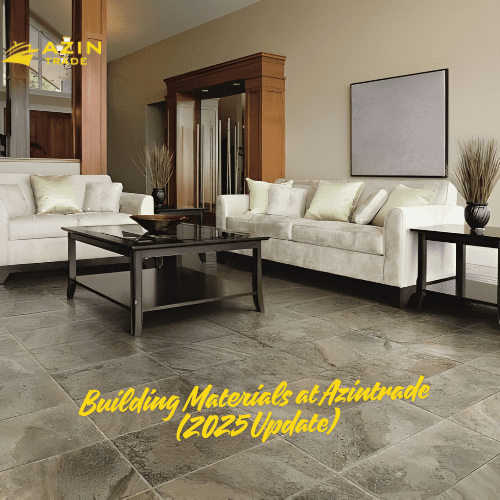The Complete, In-Depth Guide to the Key Difference Between Porcelain Tile & Ceramic Tile
Choosing between porcelain tile and ceramic tile is one of the most important decisions when selecting surfaces for residential or commercial projects. While these two materials appear similar, the key difference between porcelain and ceramic goes far beyond aesthetics. Their structure, density, performance, durability, installation requirements, and long-term behavior vary significantly. This comprehensive expert guide breaks down everything you need to know to make the smartest choice based on science, design, and real-world use.
1. What Exactly Is Ceramic Tile?
Ceramic tile is made from natural red or white clay, mixed with water, molded, and fired at moderate temperatures. This process creates a strong yet relatively porous material.
Ceramic tiles are often coated with a durable glaze that protects the surface and adds color, texture, or shine. Although ceramic is versatile and widely used, its porosity makes it more suitable for indoor environments where moisture is controlled.
2. What Makes Porcelain Tile Different?
Porcelain tile belongs to the ceramic family but is manufactured using much more refined clay and fired at extremely high temperatures. This results in an ultra-dense, ultra-strong, and nearly waterproof tile body.
Because porcelain has a water absorption rate of less than 0.5%, it’s considered an ideal option for areas exposed to heavy moisture, extreme temperature changes, and high foot traffic.
3. Key Difference Between Porcelain and Ceramic: Material Density
One of the strongest distinctions is density:
- Porcelain tile has a tightly compacted clay structure, making it extremely hard and durable.
- Ceramic tile has a lighter and more porous body, which makes cutting and installation easier but reduces long-term strength.
The higher density of porcelain also means greater resistance to impact, scratching, cracking, and wear—making porcelain a top choice for demanding environments.

4. Water Absorption & Moisture Resistance
Understanding moisture performance is crucial.
Porcelain tile is almost completely impermeable and has one of the lowest water absorption rates among all tiling materials. This makes porcelain a perfect solution for:
- Bathrooms
- Outdoor patios
- Pool areas
- Commercial kitchens
- Laundry rooms
Ceramic tile, however, absorbs more water due to its porous body. This means ceramic is best suited for:
- Indoor walls
- Low-moisture rooms
- Decorative finishes
5. Durability & Lifetime Performance
The superior material density of porcelain leads to exceptional durability. Porcelain tiles can withstand heavy foot traffic, harsh cleaning chemicals, and dramatic temperature changes without losing integrity.
Ceramic tile, though durable enough for most homes, is more prone to chipping or surface wear in high-traffic or industrial areas.
6. Design Capabilities & Aesthetic Options
Both porcelain tile and ceramic tile offer a wide range of design options, but technology gives porcelain the edge.
Porcelain Tile Design Benefits
Thanks to modern digital printing, porcelain can mimic:
- Natural stone (marble, granite, slate)
- Wood planks
- Concrete
- Terrazzo
- High-contrast veins and textures
Porcelain also allows deeper color penetration, meaning patterns often go through the tile’s body, reducing visible wear over time.
Ceramic Tile Design Benefits
Ceramic offers:
- A wide variety of glazed finishes
- Lightweight designs
- Affordable decorative options
Ceramic is ideal for large wall installations and interior projects requiring color flexibility.
7. Installation: Porcelain vs. Ceramic
Installing porcelain tile requires skill and specialized cutting tools because of its extreme hardness. This may increase installation costs but ensures long-term stability.
Ceramic tile, being softer and easier to cut, is ideal for DIY installations or projects with complex cuts and angles.
8. Cost Comparison
Choosing between porcelain and ceramic often depends on budget:
- Porcelain tile tends to cost more due to its advanced manufacturing process and high performance.
- Ceramic tile is more economical and offers excellent value for interior applications.
However, porcelain may provide a better ROI in the long run due to its superior durability and minimal maintenance requirements.
9. Best Applications for Porcelain Tile
Because of its strength, density, and moisture resistance, porcelain tile is ideal for:
- Outdoor flooring
- Commercial spaces
- High-traffic hallways
- Bathrooms and showers
- Hotel lobbies
- Industrial workspaces

10. Best Applications for Ceramic Tile
Ceramic tile excels in:
- Indoor walls
- Low-traffic living spaces
- Accent walls and decorative borders
- Budget-friendly renovations
- Kitchens and backsplashes
11. Maintenance & Cleaning Differences
Porcelain requires minimal maintenance thanks to its non-porous body. It resists stains, odors, bacteria, and moisture naturally.
Ceramic, while still easy to clean, may require additional sealing in some cases to prevent staining.
12. Lifespan & Long-Term Value
Porcelain tiles often last decades—even in harsh conditions—without losing structural integrity.
Ceramic tiles also have excellent longevity but may need replacement sooner if used in high-traffic or moisture-heavy areas.
Conclusion: Which Is Better—Porcelain or Ceramic?
The key difference between porcelain tile and ceramic tile ultimately comes down to density, water absorption, durability, and intended use.
- If you want maximum strength, moisture resistance, and long-term performance, porcelain tile is the superior choice.
- If you need an affordable, lightweight, versatile material for indoor spaces, ceramic tile is perfect.
Understanding these differences ensures you select a material that fits your project’s functional and aesthetic needs while also optimizing long-term value




